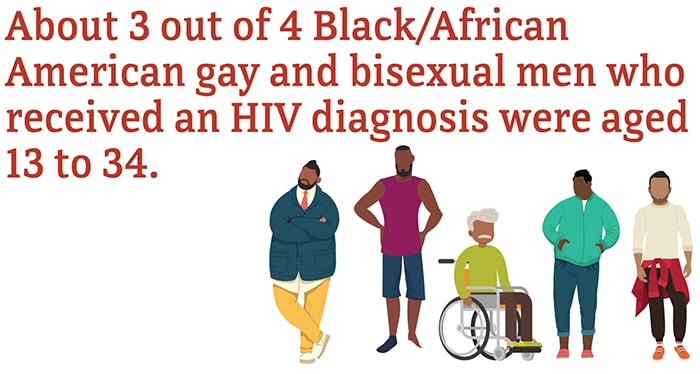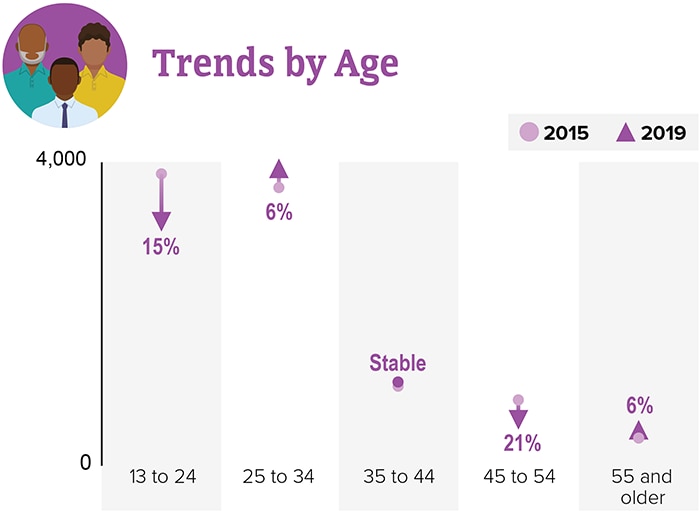HIV and African American Gay and Bisexual Men: HIV Diagnoses
Data for 2020 should be interpreted with caution due to the impact of the COVID-19 pandemic on access to HIV testing, care-related services, and case surveillance activities in state and local jurisdictions. While 2020 data on HIV diagnoses and prevention and care outcomes are available, we are not updating this web content with data from these reports.
HIV diagnoses is one of the six Ending the HIV Epidemic in the U.S. indicators. HIV diagnoses refers to the number of people who received an HIV diagnosis during a given year.




NOTE: Subpopulations representing 2% or less of HIV diagnoses among gay and bisexual men are not reflected in this chart.
* Black refers to people having origins in any of the Black racial groups of Africa. African American is a term often used for people of African descent with ancestry in North America.
† Hispanic/Latino people can be of any race.
Source: CDC. Diagnoses of HIV infection in the United States and dependent areas, 2019. HIV Surveillance Report 2021;32.
From 2015 to 2019, HIV diagnoses remained stable among Black/African American gay and bisexual men overall. But trends for HIV diagnoses among Black/African American gay and bisexual men varied by age. While good progress has been made with reducing HIV diagnoses among some age groups, efforts will continue to focus on lowering diagnoses among all age groups.

* Black refers to people having origins in any of the Black racial groups of Africa. African American is a term often used for people of African descent with ancestry in North America.
Source: CDC. Diagnoses of HIV infection in the United States and dependent areas, 2019. HIV Surveillance Report 2021;32.
- CDC. Behavioral and clinical characteristics of persons with diagnosed HIV infection—Medical Monitoring Project, United States, 2020 cycle (June 2020–May 2021). HIV Surveillance Special Report 2022;29.
- CDC. Diagnoses of HIV infection in the United States and dependent areas, 2019. HIV Surveillance Report 2021;32.
- CDC. Estimated HIV incidence and prevalence in the United States, 2015–2019 [PDF – 3 MB]. HIV Surveillance Supplemental Report 2021;26(1).
- CDC. Monitoring selected national HIV prevention and care objectives by using HIV surveillance data—United States and 6 dependent areas, 2019. HIV Surveillance Supplemental Report 2021;26(2).
- CDC. HIV infection risk, prevention, and testing behaviors among men who have sex with men—National HIV Behavioral Surveillance, 23 U.S. cities, 2017 [PDF – 1 MB]. HIV Surveillance Special Report 2019;22.
- CDC. HIV care outcomes among men who have sex with men with diagnosed HIV infection—United States, 2015. MMWR 2017;66(37):969-74.
- Marano M, Stein R, Song W, Patel D, Taylor-Aidoo N, Xu S, Scales L. HIV testing, linkage to HIV medical care, and interviews for partners services among black men who have sex with men—non-health care facilities, 20 southern U.S. jurisdictions, 2016. MMWR 2018;67(28):778-81.